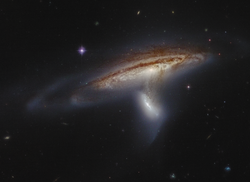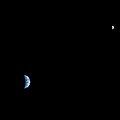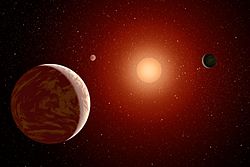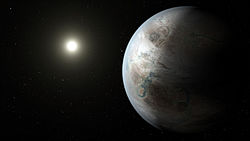Tidal locking between a pair of co-orbiting astronomical bodies occurs when one of the objects reaches a state where there is no longer any net change...
47 KB (5,091 words) - 09:10, 17 May 2025
forces, but are not caused by the rotation. Further tidal phenomena include solid-earth tides, tidal locking, breaking apart of celestial bodies and formation...
24 KB (2,884 words) - 19:46, 21 May 2025
rotation. See supersynchronous orbit. The process eventually leads to tidal locking, usually of the smaller body first, and later the larger body (e.g....
37 KB (4,808 words) - 22:36, 28 January 2025
Proxima Centauri b (section Tidal locking)
number of considerations: Both the activity of Proxima Centauri and tidal locking would hinder the establishment of these conditions on the planet. Unlike...
74 KB (8,338 words) - 23:16, 3 May 2025
dwarfs are likely to be tidally locked to their primary: that is, their days are as long as their orbits. While tidal locking may adversely affect planets...
38 KB (3,779 words) - 14:38, 17 April 2025
Arnold tongue (redirect from Phase locking)
instruments, orbital resonance and tidal locking of orbiting moons, mode-locking in fiber optics and phase-locked loops and other electronic oscillators...
21 KB (3,182 words) - 02:35, 22 March 2025
Natural satellite (section Tidal locking)
small orbital inclination and eccentricity) in the Solar System are tidally locked to their respective primaries, meaning that the same side of the natural...
43 KB (3,564 words) - 16:01, 3 May 2025
Gliese 581c (section Tidal lock)
resulting from this tidal locking may play a major role in the planet's geology. Models proposed by scientists predict that tidal heating could yield...
38 KB (3,772 words) - 03:01, 15 November 2024
dwarf systems are unlikely to be habitable, due to high probability of tidal locking, likely lack of atmospheres, and the high stellar variation many such...
47 KB (5,676 words) - 04:00, 16 April 2025
Moon (section Tidal effects)
This tidal drag makes the rotation of the Earth, and the orbital period of the Moon very slowly match. This matching first results in tidally locking the...
270 KB (26,410 words) - 13:30, 17 May 2025
become tidally locked, in which at least one object has the same side facing the other object during the course of an orbit. Tidal locking Tidal acceleration...
6 KB (863 words) - 13:55, 3 January 2025
bodies are tidally locked to each other. The dwarf planet systems Pluto–Charon and Eris–Dysnomia are the only known examples of mutual tidal locking in the...
56 KB (5,633 words) - 04:26, 17 May 2025
orbit (tidal circularization) and the rotational periods of the two bodies adjust towards matching the orbital period (tidal locking). Sustained tidal heating...
10 KB (1,240 words) - 14:46, 12 March 2025
Kepler-296e (section Tidal locking)
gravitysimulator.org. Retrieved 27 November 2023. Barnes, Rory (1 December 2017). "Tidal locking of habitable exoplanets". Celestial Mechanics and Dynamical Astronomy...
9 KB (854 words) - 22:42, 10 February 2024
results in tidal interactions stronger than those on Earth. All the planets have reached an equilibrium with slow planetary rotations and tidal locking, which...
188 KB (20,696 words) - 08:29, 20 May 2025
Tide (redirect from Tidal flow)
global atmospheric flow Tidal barrage – Dam-like structure Tidal island – Island accessible by foot at low tide Tidal locking – Situation in which an...
109 KB (13,077 words) - 15:12, 16 May 2025
TOI-2257 b (section Tidal locking)
conditions that combat tidal locking. On the other hand, the planet's eccentricity could be a factor working against tidal locking in and of itself; the...
11 KB (1,243 words) - 09:32, 13 December 2024
Orbit (section Tidal locking)
is the orbital period. See also Kepler’s third law. Some bodies are tidally locked with other bodies, meaning that one side of the celestial body is permanently...
57 KB (8,123 words) - 06:52, 24 April 2025
K2-332 b (section Tidal locking)
com. Retrieved November 21, 2023. Barnes, Rory (December 1, 2017). "Tidal locking of habitable exoplanets". Celestial Mechanics and Dynamical Astronomy...
7 KB (817 words) - 18:06, 12 March 2024
Eyeball planet (category Tidal forces)
An eyeball planet is a hypothetical type of tidally locked planet, for which tidal locking induces spatial features (for example in the geography or composition...
8 KB (806 words) - 04:30, 12 May 2025
Gliese 581g (section Tidal locking)
been dubbed "Eyeball Earth" by the author. Modeling of the effect of tidal locking on Gliese 581g's possible atmosphere, using a general circulation model...
58 KB (5,454 words) - 00:57, 23 August 2024
stabilize Earth's axis, causes tides and gradually slows Earth's rotation. Tidal locking has made the Moon always face Earth with the same side. Earth, like...
219 KB (19,417 words) - 06:55, 19 May 2025
injection locking. When the second oscillator merely disturbs the first but does not capture it, the effect is called injection pulling. Injection locking and...
16 KB (1,904 words) - 05:36, 9 January 2025
their star, including probable tidal locking. Even in a small yellow dwarf like Tau Ceti, of type G8.5V, the locking limit is at 0.4237 AU versus the...
35 KB (3,491 words) - 23:19, 18 April 2025
motion, increasing its distance from Earth and its orbital period (see tidal locking for a more detailed explanation of this process). Flywheel List of energy...
3 KB (416 words) - 13:40, 20 November 2024
Charon, Styx, Nix, Kerberos, and Hydra. Charon, the largest, is mutually tidally locked with Pluto, and is massive enough that Pluto and Charon are sometimes...
39 KB (3,708 words) - 01:44, 4 May 2025
over a location on Earth's surface at the same mean solar time. Due to tidal locking with Earth, the Moon's synodic day (the lunar day or synodic rotation...
6 KB (692 words) - 06:55, 3 February 2025
which is retrograde to the Sun. Nearly all regular satellites are tidally locked and thus have prograde rotation. Retrograde satellites are generally...
41 KB (4,723 words) - 15:41, 20 May 2025
surface of planets orbiting them at a distance that does not induce tidal locking. K-type stars may be able to support life far longer than the Sun. Whether...
111 KB (13,137 words) - 16:12, 12 May 2025
extremely close distances to the stars cause tidal locking, an important factor in habitability. For a tidally locked planet, the sidereal day is as long as...
139 KB (13,879 words) - 19:12, 24 April 2025





















